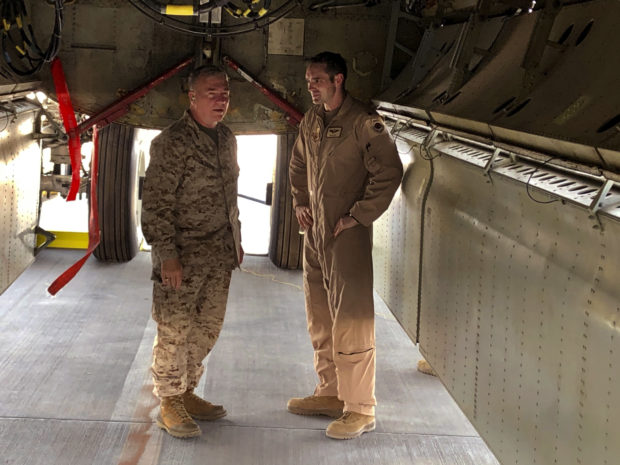US carrier in Persian Gulf region sends clear signal to Iran
ABOARD THE USS ABRAHAM LINCOLN – Under a starry sky, U.S. Navy fighter jets catapulted off the aircraft carrier’s deck and flew north over the darkened waters of the northern Arabian Sea, a unmistaken signal to Iran that the foremost symbol of the American military’s global reach is back in its neighborhood, perhaps to stay.
The USS Abraham Lincoln , with its contingent of Navy destroyers and cruisers and a fighting force of about 70 aircraft, is the centerpiece of the Pentagon’s response to what it calls Iranian threats to attack U.S. forces or commercial shipping in the Persian Gulf region.

Marine Gen. Frank McKenzie, head of U.S. Central Command, confers with an Air Force officer below the bomb bay of a B-52 bomber on Friday, June 7, 2019 at al-Udeid air base in Qatar. McKenzie said on Friday that he thinks Iran had been planning some sort of attack on shipping or U.S. forces in Iraq. Two other officials, speaking on condition of anonymity to discuss sensitive details, said Iran was at a high state of readiness in early May with its ships, submarines, surface-to-air missiles and drone aircraft. “It is my assessment that if we had not reenforced, it is entirely likely that an attack would have taken place by now,” he said. (AP Photo/Robert Burns)
In recent years, there has been no regular U.S. aircraft carrier presence in the Middle East.
U.S. officials have said that signs of heightened Iranian preparations to strike U.S. and other targets in the waters off Iran as well as in Iraq and Yemen in late April emerged shortly after the Trump administration announced it was clamping down further on Iran’s economy by ending waivers to sanctions on buyers of Iranian crude oil.
The administration went a step beyond that on Friday, announcing penalties that target Iran’s largest petrochemical company.
On Saturday the Lincoln was steaming in international waters east of Oman and about 200 miles from Iran’s southern coastline.
Article continues after this advertisementOne month after its arrival in the region, the Lincoln has not entered the Persian Gulf, and it’s not apparent that it will. The USS Gonzalez, a destroyer that is part of the Lincoln strike group, is operating in the Gulf.
Article continues after this advertisementRear Adm. John F. G. Wade, commander of the Lincoln strike group, said Iran’s naval forces have adhered to international standards of interaction with ships in his group.
“Since we’ve been operating in the region, we’ve had several interactions with Iranians,” he said.
“To this point all have been safe and professional — meaning, the Iranians have done nothing to impede our maneuverability or acted in a way which required us to take defensive measures.”
The Lincoln’s contingent of 44 Navy F-18 Super Hornets are flying a carefully calibrated set of missions off the carrier night and day, mainly to establish a visible U.S. “presence” that Marine Gen. Frank McKenzie, the head of Central Command, said Saturday seems to have caused Iran to “tinker with” its preparation for potential attacks.
He said on Friday that he thinks Iran had been planning some sort of attack on shipping or U.S. forces in Iraq.
Two other officials, speaking on condition of anonymity to discuss sensitive details, said Iran was at a high state of readiness in early May with its ships, submarines, surface-to-air missiles and drone aircraft.
“It is my assessment that if we had not reinforced, it is entirely likely that an attack would have taken place by now,” McKenzie said.
In an interview on the bridge, or command station, of the Lincoln with reporters who are traveling with him throughout the Gulf region, McKenzie said the carrier has made an important difference.
“We believe they are recalculating. They have to take this into account as they think about various actions that they might take. So we think this is having a very god stabilizing effect,” he said. /gg